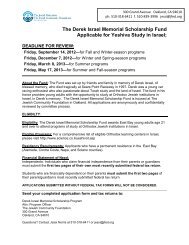East Bay Jewish Community Study - Jewish Federation of the ...
East Bay Jewish Community Study - Jewish Federation of the ...
East Bay Jewish Community Study - Jewish Federation of the ...
Create successful ePaper yourself
Turn your PDF publications into a flip-book with our unique Google optimized e-Paper software.
• Synagogue membership is higher among better educated and more affluent <strong>Jewish</strong><br />
residents. Membership is also higher in <strong>the</strong> Western region <strong>of</strong> <strong>the</strong> <strong>East</strong> <strong>Bay</strong><br />
• A small number <strong>of</strong> <strong>Jewish</strong> residents – approximately 10 percent – volunteer, participate<br />
in informal ga<strong>the</strong>rings around spiritual life, and attend <strong>Jewish</strong> <strong>the</strong>med events monthly or<br />
more.<br />
• <strong>Jewish</strong> residents who are providing <strong>the</strong>ir children with a <strong>Jewish</strong> education are much<br />
more likely to report volunteering in <strong>the</strong> community; residents who attend events are also<br />
very likely to belong to a synagogue; and residents who attend spiritual events such as a<br />
Chavurah are more likely to identify with <strong>the</strong> Conservative and <strong>Jewish</strong> renewal<br />
movements.<br />
Charity in <strong>the</strong> <strong>Jewish</strong> <strong>Community</strong><br />
• <strong>Jewish</strong> residents give generously — 80 percent have given to a non-<strong>Jewish</strong> cause in <strong>the</strong><br />
last five years. Fewer give to specifically <strong>Jewish</strong> causes.<br />
• Residents are more likely to donate in general support <strong>of</strong> <strong>Jewish</strong> organizations than to<br />
donate ei<strong>the</strong>r to Israel or to <strong>the</strong> <strong>Jewish</strong> <strong>Federation</strong> (national or <strong>East</strong> <strong>Bay</strong>).<br />
• Donations are more likely to come from more affluent and older residents, as well as<br />
people involved in o<strong>the</strong>r ways in <strong>the</strong> <strong>Jewish</strong> community (e.g., belong to a synagogue).<br />
• <strong>Federation</strong> donors have a strong connection to <strong>the</strong> community; <strong>the</strong>y both feel a strong<br />
sense <strong>of</strong> belonging and say <strong>the</strong>y are very involved in <strong>the</strong> <strong>Jewish</strong> community. They tend<br />
to be older and longer term residents <strong>of</strong> <strong>the</strong> area.<br />
• Most <strong>Federation</strong> donors give to o<strong>the</strong>r <strong>Jewish</strong> and non-<strong>Jewish</strong> causes, but <strong>the</strong>re is less<br />
reciprocity. In o<strong>the</strong>r words, donors to o<strong>the</strong>r causes are less likely to give to <strong>the</strong><br />
<strong>Federation</strong>.<br />
Feelings about <strong>the</strong> <strong>Jewish</strong> <strong>Community</strong> in <strong>the</strong> <strong>East</strong> <strong>Bay</strong><br />
• Few residents express dissatisfaction with <strong>the</strong> organized <strong>Jewish</strong> community<br />
(approximately 20 percent). A majority (66 percent) say <strong>the</strong>y are comfortable attending<br />
events put on by <strong>the</strong> <strong>East</strong> <strong>Jewish</strong> community, and most (73 percent) say <strong>the</strong>y are not<br />
uncomfortable because <strong>the</strong>y are unfamiliar with faith and tradition.<br />
• A majority <strong>of</strong> people in interfaith partnerships say that <strong>the</strong>y feel comfortable bringing non-<br />
<strong>Jewish</strong> partners to events, and a majority <strong>of</strong> parents say that <strong>the</strong> community <strong>of</strong>fers good<br />
opportunities for <strong>the</strong>ir children. A plurality say <strong>the</strong> community welcomes LGBTQ people,<br />
however, a significant number <strong>of</strong> residents are uncertain about how welcoming <strong>the</strong><br />
organized <strong>Jewish</strong> community is <strong>of</strong> <strong>the</strong> LGBTQ community.<br />
• Fifty-six percent <strong>of</strong> LGBTQ Jews say <strong>the</strong> community is welcoming to <strong>the</strong>m, though<br />
ano<strong>the</strong>r forty-one percent do not know. Only 3 percent disagree.<br />
• The bigger challenge for <strong>Jewish</strong> institutions is that many <strong>Jewish</strong> residents are simply<br />
uninterested in pursuing a <strong>Jewish</strong> life or <strong>Jewish</strong> education for <strong>the</strong>ir children.<br />
• Cost is an issue for some; however, <strong>the</strong>re is no difference in <strong>the</strong> involvement level<br />
among residents who cite cost issues versus those who do not. Cost is a higher<br />
concern among residents with children.<br />
Family Life and <strong>the</strong> <strong>Jewish</strong> <strong>Community</strong><br />
• Family life drives a great deal <strong>of</strong> <strong>Jewish</strong> involvement, particularly for parents <strong>of</strong> bar and<br />
bat mitzvah-age children. Parents <strong>of</strong> younger children are more likely to say <strong>the</strong>y are<br />
involved in <strong>Jewish</strong> life, to belong to a synagogue, and to volunteer.<br />
4




